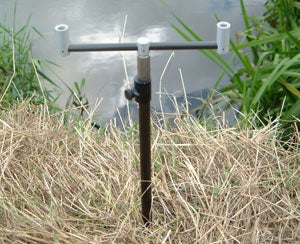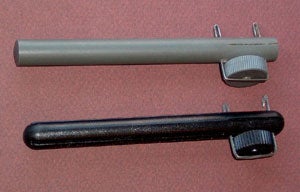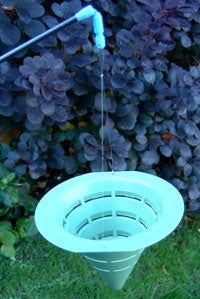Dragon’s SwimWith the popularity of the BBC’s programme, Dragon’s Den, I thought I’d look at a few products from over the years that should have been put through this kind of mill first. It might have saved people a lot of money!
The Extending BankstickFor those of you who I haven’t bored with this story before, back in the 1960s you could only buy solid or hollow banksticks at fixed lengths. Very often I would have loved an adjustable one and it wasn’t for the lack of trying to find one either. I’d searched every tackle dealer around Manchester and some around Sheffield when we ever got over that side of the hills.
I asked if I could have one to break up and since they were destined for the dustbin, no problem. I borrowed a hacksaw and cut a large section of the central pole complete with screw tightener and extender section away. A trip down to the tackle shop who at that time sold screw fittings, I suppose for if you wanted to make your own landing net handle, and this I fixed to the top end with solder. I fashioned a point to the lower sections and behold – an extending bankstick! Did I get some admiring looks? Well, the bankstick did and oh boy, if only I had patented that idea for, obviously, they have sold very well since. Of course I didn’t tell many people at the time that it was really a bra stand and I can’t remember what I did with the bust part. The Matchman Hook TyerI first became acquainted with this item in 1972 or 1973 (“I forget” is usually Graham’s quote, but mine on this occasion). They were first made by a chap in Denton near Manchester who machined them from aluminium. The cost was about the same as they are now, but the production rate was low and despite waiting months I never got mine.
It’s the grey version in the picture, yes, I still have it today and it still works. The black one is the latest model and now made by M.P.H. Associates, whoever they are. I can’t remember for the life of me now who originally designed it or whether it was patented even and I don’t think he got an awful lot out of it. Which is a pity because the design has stood the test of time and providing you have the patience to master it fully, it does tie knots on spade end hooks! The Pole Cone FeederI’m not sure now what this was actually called as I’ve long since lost the box it came in. I know his first name was Chris, but I have forgotten the inventor’s second name, sorry. He was a damned good artist and did some advertising artwork for me. So we’ll just call it the Pole Cone Feeder for now, because it used to be hung off the end of a pole via the connector.
It did everything that Chris had in mind for it; he wanted to dangle it off the end of his pole and at the same time there would still be a float rig in use from the same connector. The idea being that you could put into it some pellets or groundbait, lower it to the water whereupon it would tip over (like a spod) and empty the contents where you wanted to fish. Alternatively, you could put into it maggots or pinkies and allow them to crawl through the slits in the feeder thereby giving a constant stream of loose feed as you were fishing. So what was wrong with it? In my opinion, it wasn’t very elegant and looked like a witch’s hat, especially with the wide brim. The plastic it was made from although in essence very tough, appeared to be brittle and I suppose many anglers thought they would break it. I also think at the retail price he was asking, anglers may have thought it too expensive. Well, I haven’t seen any around on the tackle dealer’s shelves so I guess there’s perhaps a few thousand that might still be cluttering up Chris’s garage somewhere. He must have lost quite a bit on the whole process and it’s hard to judge if he learned any lesson from it. Picking yourself up from a disaster like that is difficult and sadly, I haven’t seen him since. I also stopped advertising my product so no longer required his artwork service, which was excellent (he also painted WWII aircraft). The lesson I very quickly learned about marketing is when it’s not working, stop digging an even bigger hole for yourself. Isn’t that what some of the Dragons say on TV? The Rainbow Depth FinderThis was a product that Graham reviewed not too long ago and he was being kind to it I suspect, perhaps more so than I would have been. It consists of a tape measure marked off in feet by different colours and a stock of pole winders and stickers to match the colours on the tape. The basic idea being to hang the tape from the end of your pole and allow the sinker on the other end of the tape to rest of the bottom of the swim.
I have seen skilled matchmen working and they usually know the places they will fish and the depths they are likely to find there. If not they’ll go for a practice session some days before if it’s an important match. All they will take are the float styles and hooks sizes that they think they will need and if the rig is too long they’ll shorten it on site, it only takes but a few seconds, and hardly worth spending money on a kit that doesn’t really help them. So What Lessons Do We Learn? The bankstick (I wished I had patented) addressed a problem I was having, but would have sold to other anglers who, I later found, had the same problem. Although I was working in a commercial environment I still didn’t have much savvi about making and selling stuff. My version was very heavy, but some engineer looking over it could have made it much lighter like today’s versions. The hook tyer was clearly a limited winner, just a pity that the inventor didn’t have the capital to have a mould made up to manufacture it in bulk. Of course, then he would have needed someone to market it for him and advertising wasn’t cheap even then. I don’t know how the Rosewood company did, but it was more difficult to get ideas off the ground then too. Chris’s cone was never going to get off the ground as there were already pole cups of different designs already on the market and matchmen were quite happy with them. Furthermore it was inelegant and cumbersome looking and that in a design does not sell! It wouldn’t have cost a lot to visit lots of matches and take a prototype along to explain it, to see if there would have been a big demand. I hope he’s recovered from the experience. The Rainbow system, in my opinion, is completely unnecessary. The matchmen I’ve known don’t want it as it wastes precious time and even if they used it to work out the depth they’re far happier tying their pole rigs to match the length of the sections they’d be fishing with. To get them to use it means changing their work practice and that’s impossible. In true Dragon’s Den style, I can only say “I’m out.” If you can remember, just over two years ago I designed (a new specimen quiver for Chub) that they manufactured and put on the market. It still sells well, as far as I know, but that was really pandering to my thoughts on what a quiver should look like. All I got out of it in the end was my quiver, free of charge, all £ 20 worth of it. Hardly a fortune. Very recently I have had some other ideas and I have submitted these to another company. I know I can’t develop them myself as I don’t have access to either the funds or the technology. My only hope is that someone with a little imagination will see what I am striving for and perhaps bring them to market. Again, I might get something out of it, but I shan’t hold my breath as I know full well it will merely be the crumbs and not the sandwich. I met up with Greg Holloway (of Hopkins & Holloway) a while ago and discussed with him my design for a new handle and reel seat. I didn’t want to put too much details into the conversation, but suffice to say that he told me Fuji would not develop anything that they hadn’t thought of. A pity really because if they aren’t bothered to further their own designs then the reel seat and handle market is almost at a stalemate, other than Abu and Shimano developing their versions, which I must say, are good. The problem is that a lot of independent manufacturers buy readymade reel seats from present stock and that usually means Fuji. The lesson for us all then is do your homework first, find out by asking around if there really would be a demand for your idea. If you can afford to develop it and you have some marketing skills then go it alone, but don’t bury yourself in debt and avoid going for loans and overdrafts. If you can’t afford to go this route then throw yourself at the mercy of a big manufacturer and see if they’ll make it and put it on the market. If not – forget it! Now, a quick letter to TickleTackle. “Dear Kev……” |
Welcome!Log into your account















